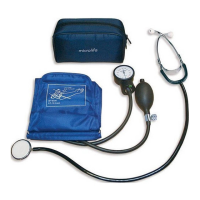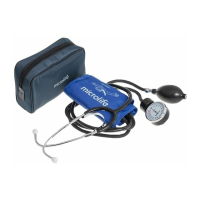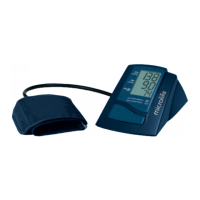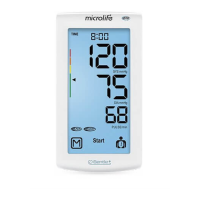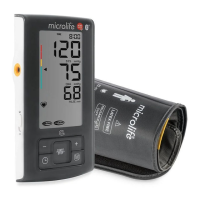3Microlife BP AG1-40
EN
Measuring procedure
1. Place the chest piece 6 underneath the cuff 2 or 1-2 cm
below it. Make sure the chest piece is in contact with the skin
and lies on the brachial artery.
2. Plug in the ear piece 7 and check, if the chest piece is placed
correctly, so that the Korotkoff sounds appear the loudest.
3. Close the valve 4 on the pump ball 3 by turning the screw
clockwise. Do not over-tighten.
4. Take the pump ball 3 in your free hand (the arm you are not
using to measure) and pump up the cuff. Watch the pressure
indicator on the manometer 1 and pump up to approx.
40 mmHg higher than the expected systolic value (the upper
value).
Inflate to 200 mmHg if you are not sure about the expected
value.
5. Open the valve 4 slowly by turning the screw counter clock-
wise whilst holding the stethoscope chest piece 6 on the
brachial artery. Listen carefully as the cuff begins to deflate.
Note the reading on the manometer 1 as soon as you hear a
faint, rhythmic tapping or thumping sounds. This is the
systolic blood pressure reading.
6. Allow the pressure to continue dropping at the same deflation
rate. Note the reading on the manometer 1 as soon as the
thumping sound stops. This is the diastolic blood pressure
reading.
7. Deflate the cuff completely.
8. Repeat the measurement at least two further times and record
your values, date and time immediately after finishing the
measurements.
9. Remove the cuff and the stethoscope.
4. Malfunction / Troubleshooting
If problems occur when using the device, the following points
should be checked and if necessary, the corresponding measures
are to be taken:
5. Safety, care, accuracy test and disposal
Follow instructions for use. This document provides important
product operation and safety information regarding this device.
Please read this document thoroughly before using the device
and keep for future reference.
Description Potential cause and remedy
The sound transmis-
sion is poor, distorted
or there is extraneous
noise.
Check the ear pieces if they are dirty
or cracked. If not, make sure you
wear them properly.
Check the tube if it is broken or
twisted.
Check the chest piece if there is any
damage.
Make sure the chest piece is in
contact with the skin and lies on the
brachial artery. Clean or replace any
defective parts if found to avoid inac-
curate reading.
The pressure does not
rise although the pump
ball 3 is pumping.
Make sure that the valve is closed.
Make sure the cuff is properly
connected to bulb and manometer.
Check if the cuff, tube and/or bulb is
leaking. Replace the defective parts
if any.
The deflation rate can
not be set to 2-
3 mmHg/sec. by
adjusting the valve 4.
Disassemble the valve from pump ball
to check if there is any blockage in the
airway of the valve. Clean the blockage
and try again. If it still does not work,
replace it to avoid inaccurate readings.
The manometer
needle is not at 0 ± 3
mmHg at rest.
Make sure that the valve is
completely open for zero check.
If still more than 3 mmHg deviation,
contact your dealer to recalibrate the
manometer.
If you think the results are unusual, please read through the
information in «Section 1.» carefully.
Safety and protection

